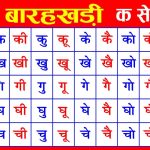English Barakhadi is a simplified system for understanding the combination of consonants and vowels in the English language. It is inspired by the traditional Barakhadi used in Indian languages, which is a chart that shows the combination of consonants with the twelve vowels.
In English, Barakhadi serves as a bridge to help learners, especially those unfamiliar with the English script, understand how different consonants can be combined with vowels to form syllables and words.
Barakhadi Full Chart
The English Barakhadi chart is a visual representation that lists English consonants alongside the vowels. Each consonant is paired with the vowels to show how they blend to form basic syllables. For example, the consonant ‘B’ can combine with vowels to form ‘Ba’, ‘Be’, ‘Bi’, ‘Bo’, and ‘Bu’. This chart is an essential tool for beginners as it visually breaks down the complexities of English pronunciation.
Below is a simplified version of the English Barakhadi chart:
| अ / A / अ | आ / Aa / आ | इ / I / इ | ई / Ee / ई | उ / U / उ | ऊ / Oo / ऊ | ऋ / Ri / ऋ | ए / E / ए | ऐ / Ai / ऐ | ओ / O / ओ | औ / Au / औ | अं / Am / अं | अः / Ah / अः |
|---|
| क / Ka / क | का / Kaa / का | कि / Ki / कि | की / Kee / की | कु / Ku / कु | कू / Koo / कू | कृ / Kri / कृ | के / Ke / के | कै / Kai / कै | को / Ko / को | कौ / Kau / कौ | कं / Kam / कं | कः / Kah / कः |
| ख / Kha / ख | खा / Khaa / खा | खि / Khi / खि | खी / Khee / खी | खु / Khu / खु | खू / Khoo / खू | खृ / Khri / खृ | खे / Khe / खे | खै / Khai / खै | खो / Kho / खो | खौ / Khau / खौ | खं / Kham / खं | खः / Khah / खः |
| ग / Ga / ग | गा / Gaa / गा | गि / Gi / गि | गी / Gee / गी | गु / Gu / गु | गू / Goo / गू | गृ / Gri / गृ | गे / Ge / गे | गै / Gai / गै | गो / Go / गो | गौ / Gau / गौ | गं / Gam / गं | गः / Gah / गः |
| घ / Gha / घ | घा / Ghaa / घा | घि / Ghi / घि | घी / Ghee / घी | घु / Ghu / घु | घू / Ghoo / घू | घृ / Ghri / घृ | घे / Ghe / घे | घै / Ghai / घै | घो / Gho / घो | घौ / Ghau / घौ | घं / Gham / घं | घः / Ghah / घः |
| ङ / Nga / ङ | ङा / Ngaa / ङा | ङि / Ngi / ङि | ङी / Ngee / ङी | ङु / Ngu / ङु | ङू / Ngoo / ङू | ङृ / Ngri / ङृ | ङे / Nge / ङे | ङै / Ngai / ङै | ङो / Ngo / ङो | ङौ / Ngau / ङौ | ङं / Ngam / ङं | ङः / Ngah / ङः |
| च / Cha / च | चा / Chaa / चा | चि / Chi / चि | ची / Chee / ची | चु / Chu / चु | चू / Choo / चू | चृ / Chri / चृ | चे / Che / चे | चै / Chai / चै | चो / Cho / चो | चौ / Chau / चौ | चं / Cham / चं | चः / Chah / चः |
| छ / Chha / छ | छा / Chhaa / छा | छि / Chhi / छि | छी / Chhee / छी | छु / Chhu / छु | छू / Chhoo / छू | छृ / Chhri / छृ | छे / Chhe / छे | छै / Chhai / छै | छो / Chho / छो | छौ / Chhau / छौ | छं / Chham / छं | छः / Chhah / छः |
| ज / Ja / ज | जा / Jaa / जा | जि / Ji / जि | जी / Jee / जी | जु / Ju / जु | जू / Joo / जू | जृ / Jri / जृ | जे / Je / जे | जै / Jai / जै | जो / Jo / जो | जौ / Jau / जौ | जं / Jam / जं | जः / Jah / जः |
| झ / Jha / झ | झा / Jhaa / झा | झि / Jhi / झि | झी / Jhee / झी | झु / Jhu / झु | झू / Jhoo / झू | झृ / Jhri / झृ | झे / Jhe / झे | झै / Jhai / झै | झो / Jho / झो | झौ / Jhau / झौ | झं / Jham / झं | झः / Jhah / झः |
| ञ / Nya / ञ | ञा / Nyaa / ञा | ञि / Nyi / ञि | ञी / Nyee / ञी | ञु / Nyu / ञु | ञू / Nyoo / ञू | ञृ / Nyri / ञृ | ञे / Nye / ञे | ञै / Nyai / ञै | ञो / Nyo / ञो | ञौ / Nyau / ञौ | ञं / Nyam / ञं | ञः / Nyah / ञः |
| ट / Ta / ट | टा / Taa / टा | टि / Ti / टि | टी / Tee / टी | टु / Tu / टु | टू / Too / टू | टृ / Tri / टृ | टे / Te / टे | टै / Tai / टै | टो / To / टो | टौ / Tau / टौ | टं / Tam / टं | टः / Tah / टः |
| ठ / Tha / ठ | ठा / Thaa / ठा | ठि / Thi / ठि | ठी / Thee / ठी | ठु / Thu / ठु | ठू / Thoo / ठू | ठृ / Thri / ठृ | ठे / The / ठे | ठै / Thai / ठै | ठो / Tho / ठो | ठौ / Thau / ठौ | ठं / Tham / ठं | ठः / Thah / ठः |
| ड / Da / ड | डा / Daa / डा | डि / Di / डि | डी / Dee / डी | डु / Du / डु | डू / Doo / डू | डृ / Dri / डृ | डे / De / डे | डै / Dai / डै | डो / Do / डो | डौ / Dau / डौ | डं / Dam / डं | डः / Dah / डः |
| ढ / Dha / ढ | ढा / Dhaa / ढा | ढि / Dhi / ढि | ढी / Dhee / ढी | ढु / Dhu / ढु | ढू / Dhoo / ढू | ढृ / Dhri / ढृ | ढे / Dhe / ढे | ढै / Dhai / ढै | ढो / Dho / ढो | ढौ / Dhau / ढौ | ढं / Dham / ढं | ढः / Dhah / ढः |
| ण / Na / ण | णा / Naa / णा | णि / Ni / णि | णी / Nee / णी | णु / Nu / णु | णू / Noo / णू | णृ / Nri / णृ | णे / Ne / णे | णै / Nai / णै | णो / No / णो | णौ / Nau / णौ | णं / Nam / णं | णः / Nah / णः |
| त / Ta / त | ता / Taa / ता | ति / Ti / ति | ती / Tee / ती | तु / Tu / तु | तू / Too / तू | तृ / Tri / तृ | ते / Te / ते | तै / Tai / तै | तो / To / तो | तौ / Tau / तौ | तं / Tam / तं | तः / Tah / तः |
| थ / Tha / थ | था / Thaa / था | थि / Thi / थि | थी / Thee / थी | थु / Thu / थु | थू / Thoo / थू | थृ / Thri / थृ | थे / The / थे | थै / Thai / थै | थो / Tho / थो | थौ / Thau / थौ | थं / Tham / थं | थः / Thah / थः |
| द / Da / द | दा / Daa / दा | दि / Di / दि | दी / Dee / दी | दु / Du / दु | दू / Doo / दू | दृ / Dri / दृ | दे / De / दे | दै / Dai / दै | दो / Do / दो | दौ / Dau / दौ | दं / Dam / दं | दः / Dah / दः |
| ध / Dha / ध | धा / Dhaa / धा | धि / Dhi / धि | धी / Dhee / धी | धु / Dhu / धु | धू / Dhoo / धू | धृ / Dhri / धृ | धे / Dhe / धे | धै / Dhai / धै | धो / Dho / धो | धौ / Dhau / धौ | धं / Dham / धं | धः / Dhah / धः |
| न / Na / न | ना / Naa / ना | नि / Ni / नि | नी / Nee / नी | नु / Nu / नु | नू / Noo / नू | नृ / Nri / नृ | ने / Ne / ने | नै / Nai / नै | नो / No / नो | नौ / Nau / नौ | नं / Nam / नं | नः / Nah / नः |
| प / Pa / प | पा / Paa / पा | पि / Pi / पि | पी / Pee / पी | पु / Pu / पु | पू / Poo / पू | पृ / Pri / पृ | पे / Pe / पे | पै / Pai / पै | पो / Po / पो | पौ / Pau / पौ | पं / Pam / पं | पः / Pah / पः |
| फ / Pha / फ | फा / Phai / फा | फि / Phi / फि | फी / Phee / फी | फु / Phu / फु | फू / Phoo / फू | फृ / Phri / फृ | फे / Phe / फे | फै / Phai / फै | फो / Pho / फो | फौ / Phau / फौ | फं / Pham / फं | फः / Phah / फः |
| ब / Ba / ब | बा / Baa / बा | बि / Bi / बि | बी / Bee / बी | बु / Bu / बु | बू / Boo / बू | बृ / Bri / बृ | बे / Be / बे | बै / Bai / बै | बो / Bo / बो | बौ / Bau / बौ | बं / Bam / बं | बः / Bah / बः |
| भ / Bha / भ | भा / Bhaa / भा | भि / Bhi / भि | भी / Bhee / भी | भु / Bhu / भु | भू / Bhoo / भू | भृ / Bhri / भृ | भे / Bhe / भे | भै / Bhai / भै | भो / Bho / भो | भौ / Bhau / भौ | भं / Bham / भं | भः / Bhah / भः |
| म / Ma / म | मा / Maa / मा | मि / Mi / मि | मी / Mee / मी | मु / Mu / मु | मू / Moo / मू | मृ / Mri / मृ | मे / Me / मे | मै / Mai / मै | मो / Mo / मो | मौ / Mau / मौ | मं / Mam / मं | मः / Mah / मः |
| य / Ya / य | या / Yaa / या | यि / Yi / यि | यी / Yee / यी | यु / Yu / यु | यू / Yoo / यू | यृ / Yri / यृ | ये / Ye / ये | यै / Yai / यै | यो / Yo / यो | यौ / Yau / यौ | यं / Yam / यं | यः / Yah / यः |
| र / Ra / र | रा / Raa / रा | रि / Ri / रि | री / Ree / री | रु / Ru / रु | रू / Roo / रू | ऋ / Ri / ऋ | रे / Re / रे | रै / Rai / रै | रो / Ro / रो | रौ / Rau / रौ | रं / Ram / रं | रः / Rah / रः |
| ल / La / ल | ला / Laa / ला | लि / Li / लि | ली / Lee / ली | लु / Lu / लु | लू / Loo / लू | लृ / Lri / लृ | ले / Le / ले | लै / Lai / लै | लो / Lo / लो | लौ / Lau / लौ | लं / Lam / लं | लः / Lah / लः |
| व / Va / व | वा / Vaa / वा | वि / Vi / वि | वी / Vee / वी | वु / Vu / वु | वू / Voo / वू | वृ / Vri / वृ | वे / Ve / वे | वै / Vai / वै | वो / Vo / वो | वौ / Vau / वौ | वं / Vam / वं | वः / Vah / वः |
| श / Sha / श | शा / Shaa / शा | शि / Shi / शि | शी / Shee / शी | शु / Shu / शु | शू / Shoo / शू | श्र / Shri / श्र | शे / She / शे | शै / Shai / शै | शो / Sho / शो | शौ / Shau / शौ | शं / Sham / शं | शः / Shah / शः |
| ष / Sha / ष | षा / Shaa / षा | षि / Shi / षि | षी / Shee / षी | षु / Shu / षु | षू / Shoo / षू | षृ / Shri / षृ | षे / She / षे | षै / Shai / षै | षो / Sho / षो | षौ / Shau / षौ | षं / Sham / षं | षः / Shah / षः |
| स / Sa / स | सा / Saa / सा | सि / Si / सि | सी / See / सी | सु / Su / सु | सू / Soo / सू | सृ / Sri / सृ | से / Se / से | सै / Sai / सै | सो / So / सो | सौ / Sau / सौ | सं / Sam / सं | सः / Sah / सः |
| ह / Ha / ह | हा / Haa / हा | हि / Hi / हि | ही / Hee / ही | हु / Hu / हु | हू / Hoo / हू | हृ / Hri / हृ | हे / He / हे | है / Hai / है | हो / Ho / हो | हौ / Hau / हौ | हं / Ham / हं | हः / Hah / हः |
| क्ष / Ksha / क्ष | क्षा / Kshaa / क्षा | क्षि / Kshi / क्षि | क्षी / Kshee / क्षी | क्षु / Kshu / क्षु | क्षू / Kshoo / क्षू | क्षृ / Kshri / क्षृ | क्षे / Kshe / क्षे | क्षै / Kshai / क्षै | क्षो / Ksho / क्षो | क्षौ / Kshau / क्षौ | क्षं / Ksham / क्षं | क्षः / Kshah / क्षः |
| त्र / Tra / त्र | त्रा / Traa / त्रा | त्रि / Tri / त्रि | त्री / Tree / त्री | त्रु / Tru / त्रु | त्रू / Troo / त्रू | त्रृ / Tri / त्रृ | त्रे / Tre / त्रे | त्रै / Trai / त्रै | त्रो / Tro / त्रो | त्रौ / Trau / त्रौ | त्रं / Tram / त्रं | त्रः / Trah / त्रः |
| ज्ञ / Gya / ज्ञ | ज्ञा / Gyaa / ज्ञा | ज्ञि / Gyi / ज्ञि | ज्ञी / Gyee / ज्ञी | ज्ञु / Gyu / ज्ञु | ज्ञू / Gyoo / ज्ञू | ज्ञृ / Gyri / ज्ञृ | ज्ञे / Gye / ज्ञे | ज्ञै / Gyai / ज्ञै | ज्ञो / Gyo / ज्ञो |
[save_as_pdf_pdfcrowd]
This chart shows how each consonant can be paired with each of the five vowels (A, E, I, O, U) to create simple syllables. By practicing these combinations, learners can build a foundation for reading and pronouncing English words.
History and Origin of Barakhadi
The concept of Barakhadi originates from Indian languages where it is used to teach the combination of consonants and vowels. Over time, the idea was adapted for English learners, particularly for those who find it challenging to understand English phonetics. The English Barakhadi is a relatively modern educational tool that has been developed to simplify the learning process for non-native speakers and young learners.
Importance of English Barakhadi in Language Learning
English Barakhadi is important because it offers a structured approach to learning how to pronounce and spell English words. By breaking down the language into smaller, more manageable parts, learners can gradually build their understanding and fluency. This method is particularly useful for early learners, ESL students, and anyone struggling with English phonetics.
Structure and Format of English Barakhadi
The structure of English Barakhadi follows a grid format, where consonants are listed on one axis and vowels on the other. Each cell in the grid shows the combination of a consonant with a vowel, helping learners visualize how different sounds are formed. This format makes it easy to see patterns and similarities, which can be helpful in both reading and pronunciation exercises.
Phonetics and Pronunciation in English Barakhadi
Phonetics is the study of sounds, and in the context of English Barakhadi, it refers to how consonants and vowels are pronounced when combined. English Barakhadi emphasizes the correct pronunciation of each combination, which is crucial for effective communication. By learning the phonetic sounds through Barakhadi, learners can improve their spoken English and reduce mispronunciations.
Comparison with Traditional Indian Barakhadi
Traditional Indian Barakhadi and English Barakhadi serve similar educational purposes but differ in the scripts and sounds they represent. Indian Barakhadi is based on scripts like Devanagari, used in languages like Hindi and Marathi, where each consonant-vowel combination has a distinct form. In contrast, English Barakhadi uses the Latin alphabet, and while the concept is similar, the application is adjusted for the sounds and spelling rules of English.
English Alphabets and Their Corresponding Barakhadi Sounds
In English Barakhadi, each alphabet corresponds to different sounds when combined with vowels. For instance, the letter ‘C’ can be combined with ‘a’, ‘e’, ‘i’, ‘o’, ‘u’ to form ‘Ca’, ‘Ce’, ‘Ci’, ‘Co’, ‘Cu’. Understanding these combinations helps learners grasp how different sounds are made, which is a foundational skill in language acquisition.
Teaching English Barakhadi to Kids: Strategies and Techniques
Teaching English Barakhadi to kids involves using strategies that are engaging and easy to understand. Visual aids, such as charts and flashcards, are effective tools. Interactive methods like singing Barakhadi songs, using rhymes, or incorporating games can make learning more fun and less intimidating for children. Repetition and consistent practice are key to helping kids memorize the combinations and their sounds.
Interactive Activities for Learning English Barakhadi
Interactive activities can greatly enhance the learning experience of English Barakhadi. Activities like matching games, fill-in-the-blank exercises, and pronunciation drills allow learners to apply what they have learned in a practical context. Using digital tools and apps that focus on phonics and Barakhadi can also provide a dynamic learning environment, making the process engaging and effective.
English Barakhadi Worksheets and Practice Materials
Worksheets and practice materials for English Barakhadi are designed to reinforce learning. These materials typically include exercises like tracing letters, filling out Barakhadi charts, and practicing writing syllables. Worksheets can also include puzzles and crosswords that use Barakhadi combinations, providing a fun way to test understanding and reinforce memory.
Common Challenges in Learning English Barakhadi
Learning English Barakhadi can present challenges, particularly for those who are new to the English language. Some common difficulties include confusion over similar-sounding letters, mispronunciation of vowel sounds, and remembering the combinations. Patience and practice are essential to overcoming these challenges. Teachers and parents can support learners by providing clear explanations and regular practice opportunities.
Benefits of Using English Barakhadi for ESL Students
English Barakhadi is especially beneficial for ESL (English as a Second Language) students as it provides a clear and systematic way to learn English pronunciation and spelling. By breaking down words into smaller syllables, ESL students can build their confidence in speaking and reading English. The visual and repetitive nature of Barakhadi makes it easier for students to memorize and recall information, aiding in faster language acquisition.
Incorporating English Barakhadi into the Classroom Curriculum
Incorporating English Barakhadi into the classroom curriculum involves integrating it with regular phonics and language lessons. Teachers can use Barakhadi charts as a reference tool during lessons and create activities that align with the curriculum goals. By embedding Barakhadi into daily lessons, students can practice consistently, helping them build a strong foundation in English language skills.
English Barakhadi for Adults: Tools and Resources
Adults learning English can also benefit from Barakhadi, although the approach might be slightly different from that used with children. Tools such as pronunciation guides, Barakhadi apps, and online resources can provide adults with the practice they need. Barakhadi can be particularly helpful for adult learners who struggle with English pronunciation or who are visual learners, as it breaks down complex words into manageable parts.
Future of English Barakhadi in Language Education
The future of English Barakhadi in language education looks promising as it continues to be a useful tool for teaching English pronunciation and phonetics. With the increasing use of digital tools in education, English Barakhadi can be integrated into e-learning platforms, making it accessible to a wider audience. As language learning evolves, Barakhadi may become a standard component in phonics education for both children and adults.
FAQs
What is English Barakhadi?
English Barakhadi is a learning tool that combines English consonants with vowels to form syllables, helping learners understand pronunciation and spelling.
Who can benefit from learning English Barakhadi?
English Barakhadi is beneficial for young learners, ESL students, and anyone struggling with English pronunciation.
How does English Barakhadi differ from traditional Indian Barakhadi?
While both are educational tools for learning language combinations, English Barakhadi uses the Latin alphabet, whereas traditional Indian Barakhadi uses scripts like Devanagari.
Can adults learn English Barakhadi?
Yes, adults can learn English Barakhadi, and it can be particularly helpful for those who need to improve their English pronunciation.
What are some strategies for teaching English Barakhadi to kids?
Effective strategies include using visual aids, interactive activities, and consistent practice to help children memorize the combinations and their sounds.
Latest Posts
- Step-by-step guide to download and apply for jee mains admit card 202
- Comprehensive 2025 government holidays and recruitment details for job seekers
- JEE Mains Admit Card 2025: Your Step-by-Step Guide to Downloading the Hall Ticket
- Everything You Need to Know About 2025 Government Holidays Recruitment
- Comprehensive Guide to rrb d group recruitment 2025 – Eligibility, Vacancies, and Application
- Detailed guide to nps trust recruitment 2025 vacancies, eligibility and apply process
- Comprehensive guide to hpcl recruitment 2025 notification, vacancies, and application process
- ignou bed admission 2025 complete recruitment guide with eligibility and process
- Comprehensive Guide to Indian Army Agniveer Recruitment 2025 Notification and Jobs
- Everything You Must Know About CBSE Board Exams 2025 Changes & New Rules






